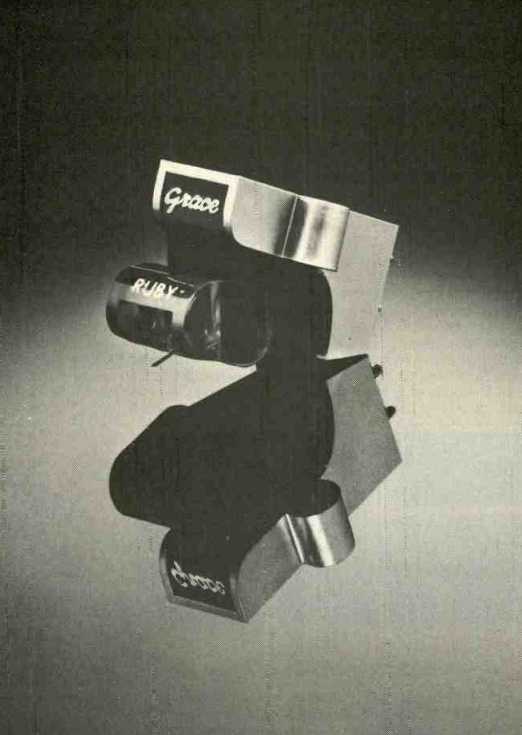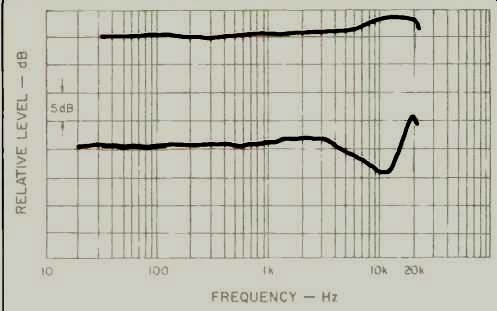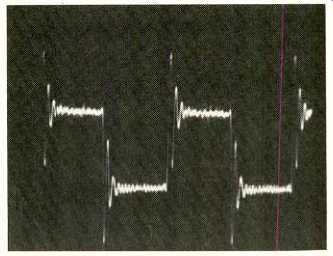
Manufacturer's Specifications:
Type: Fixed coil (moving magnet).
Frequency Response: 10 Hz to 50 kHz, ±2 dB.
Output: 2.6 mV at 5 cm/S at 1 kHz.
Impedance: 1.7 kilohms at 1 kHz.
Recommended Load Resistance: 47 kilohms.
Recommended Load Capacitance: 220 pF.
Separation: 30 dB at 1 kHz.
Stylus: Elliptical type/extended range, nude-mounted on a ruby cantilever.
Stylus Pressure Range: 0.5 to 2 grams.
Standard Pressure: 1.2 grams.
Compliance: 25 x 10^-6 cm/dyne.
Tip Mass: 0.35 mg.
Square-Wave Rise-Time: 10 µS.
Price: $300.00.
Company Address: c/o Sumiko, P.O. Box 5046, Berkeley, Cal. 94705.
I am amazed at the number of good phono cartridges that are currently available in the U.S.A. As most cartridges originate in Japan, I am inclined to believe that the Japanese enjoy nearly a world-wide monopoly in the manufacturing of "state-of-the-art" phono cartridges, both fixed- and moving-coil types. Among these are the well-established Grace F-9 series of moving-magnet phono cartridges manufactured by the Shinagawa Musen Co., Ltd. of Tokyo and sold in the U.S.A. by Sumiko, Inc.
Among the advances the Grace F-9s have utilized over the years is their Omni-Axial® Pivot, which frees the stylus from aberrations caused by nonlinearities in the suspension system-longitudinal drag distortion. In most cartridges, the damper and pivot point coincide, causing hysteresis effects at the exact point where the system should be linear. In the F-9 a tension wire keeps the cantilever poised while the damper keeps it centered. This setup is akin to that of the finest moving-coil cartridges.
The Grace F-9E and the F-9E Ruby are quite similar, with the bodies and styli relatively identical. The styli are made from Ogura's best "Vital" diamonds, which means that each is shaped from a diamond block of rectangular cross-section having one-half the mass of conventional square-shank diamonds, thereby allowing a significant reduction in effective tip mass. With a lower effective tip mass, the stylus can respond much more quickly and precisely as it is pushed from side to side in a moving record groove.
The stylus of the F-9E Ruby phono cartridge, with its precisely elongated elliptical contact area (0.2 x 0.7 mil or 5 x 18μ), is polished to a mirror-like smoothness and nude-mounted on a ruby cantilever. This cantilever is made from a ruby rod; ruby is second in hardness only to diamond. Since ruby also exhibits much less resonance and flexing than any metal cantilever, it allows a virtually perfect one-to-one energy transfer from stylus to generating element. This, in turn, provides both an improved resolution of detail and an improved transient response.
Measurements

Fig. 1--Frequency response and separation.

Fig. 2--Response to a 1-kHz square wave.
The Grace F-9E Ruby phono cartridge was mounted in an Audio-Technica AT-S headshell and used with the Technics EPA-A250 (S-shaped) interchangeable tonearm unit attached to the Technics EPA-500 tonearm base, which was mounted on a Technics SP-10 Mk II turntable. The cartridge was oriented in the headshell and tonearm with the Dennesen Geometric Soundtracktor.
Laboratory tests were conducted at an ambient tempera ture of 67° F (19.44° C) and a relative humidity of 58%, ±3%. The manufacturer's recommended stylus force of 1.2 grams was most unsatisfactory in my tonearm. The optimum tracking force was determined to be 1.7 grams, with an anti-skating force of 2.2 grams. The load resistance was 47 kilohms, and the load capacitance was 410 pF. Because of the large difference in the tracking force as well as in the load capacitance from that recommended, I called Sumiko's David Fletcher for a possible explanation. He said the 1.2-gram tracking force given in their literature was an error and that they measured the Grace F-9E Ruby parameters at a tracking force of 1.5 grams. He was, however, unable to explain my finding that the optimum cartridge load capacitance was almost double the recommended figure. My measurements and listening tests were performed under the conditions stated above.
At this point, a brief discussion relative to the problem of fixed-coil phono cartridge loading capacitance is in order.
There are some cartridges of the moving-magnet or moving-iron type (but not moving coil) that are sensitive to variations in capacitance loading, while others of the same type are not affected. As much as 5 dB variation in frequency response has been seen in improperly terminated phono cartridges. However, cartridges sensitive to capacitance loading may tolerate as much as a 20% mismatch without appreciably affecting the frequency response. Reduced cartridge terminating capacitance can cause a peak at the 10 to 20-kHz region as well as a depressed treble response from 2.5 to 10 kHz. Conversely, a very high capacitive load can depress the high-end response. One of the factors contributing to incorrect capacitive loading has been the interconnecting cable used between the tonearm-cartridge output and the phono input of the preamplifier. I have found that dual phone cables supplied by various manufacturers do not have reasonably identical capacitances in each half of the dual cable. Not infrequently, more than a 65% difference in cable capacitance has been measured in many dual cables, thus adversely affecting the load in one channel. The result is an appreciable difference in interchannel response, and the reproduced music is quite unnatural.
As is my practice, measurements are made on both channels, but only the left channel is reported (unless there is a significant difference between the two channels, in which case both channels are reported).
The following test records were used in making the reported measurements: Columbia STR-100 and STR-112; Shure TTR-103, TTR-109, TTR-110, TTR-115, TTR-117; Deutsches HiFi No. 2; Nippon Columbia Audio Technical Record (PCM) XL-7004; B & K 0R-2010, and Ortofon 0002.
Frequency response, using the Columbia STR-100 test record (Fig. 1), was + 2.5,- 0.25 dB from 40 Hz to 20 kHz; with a gradual rise commencing at 4 kHz, + 1 dB at 8 kHz, +2 dB at 12 kHz, +2.5 dB at 15 kHz, and dropping to + 1.75 dB at 20 kHz. Separation was 19.3 dB at 1 kHz, 26.75 dB at 10 kHz, 28 dB at 12 kHz, 22.75 dB at 15 kHz, and 17 dB at 20 kHz. From these data it is quite evident that the Grace F-9E Ruby has an excellent frequency response and a good high-frequency separation. The 1-kHz square-wave response is consistent with the wide frequency response of the F-9E Ruby. The square-wave photo, Fig. 2, shows that there is a large overshoot (not unlike moving-coil cartridges'), the full amplitude of the square wave, followed by low-level ringing that decays rapidly. This is apparently due to a relatively undamped stylus resonance that takes place at about 32 kHz. The arm-cartridge low-frequency resonance was almost impossible to measure with the EPA-A250 "S" arm unit. After disabling the arm's anti-resonance unit, the arm-cartridge low-frequency, lateral resonance point for the left channel was 8 Hz with a 2.5 dB rise, while for the right channel it was also 8 Hz, with a 3.5 dB rise.
Vertical resonance was at 7 Hz. Neither the lateral nor the vertical low-frequency resonance was measurable when the arm's anti-resonance unit was used. The high-frequency resonance point was at 32 kHz.
Using the Dynamic Sound Devices DMA-1 Dynamic Mass Analyzer, the arm-cartridge dynamic mass was measured as 20 grams, and the dynamic vertical compliance as 25 x 10-6 cm/dyne at the vertical resonance frequency of 7 Hz.
The anti-resonance unit on the arm was defeated for this test, since no resonance is measurable when the device is functioning.
The harmonic distortion components of the 1-kHz, 3.54 cm/S rms 45° velocity signal from the Columbia STR-100 were 2.8% second harmonic and 0.45% third harmonic, with less than 0.25% higher order terms.
The vertical stylus angle measured 31.5° using the Vertical Tracking Angle Meter (Inclination Meter), Model 3002, developed by the CBS Technology Center. This is one of the highest vertical stylus angles I have ever measured.
Other measured data are:
Wt., 6.0 g; d.c. res., 626 ohms; opt. tracking force, 1.7 g; opt. anti-skating force, 2.2 g; output, 1.1 mV/cm/S; IM distortion (4:1), +9 dB lateral, 200/4000 Hz, 1.7%; +6 dB vertical, 200/4000 Hz, 6.4%; crosstalk (using Shure TTR-109), left:-24 dB, right:-26.4 dB; channel balance, 1.8 dB; trackability: high freq. (10.8 kHz, pulsed), 30 cm/S, mid freq. (1000 and 1500 Hz, lat. cut), 31.5 cm/S, low freq. (400 and 4000 Hz, lat. cut), 24 cm/S; Deutsches HiFi No. 2, 300-Hz test band was tracked cleanly to 77 microns (0.0077 cm) lateral at 14.50 cm/S at +8.70 dB and 55.4 microns (0.00554 cm) vertical at 10.32 cm/S at + 5.86 dB.
The Grace F-9E Ruby phono cartridge played all test bands cleanly on the Shure Obstacle Course Era III musical test record. On the Shure Obstacle Course Era IV test record, the cartridge experienced some difficulty playing level 5 of the orchestral bells, harp and flute, and flute and bells test bands. Needless to say, the cartridge played very well, inasmuch as peak recorded velocities on level 5 for the combined instruments exceed 45 and 50 cm/S, respectively. The peak recorded velocity of commercial records aver ages about 15 cm/S.
Use and Listening Tests
As usual, I performed many hours of listening tests, both before and after measurement. Equipment used in the evaluation included a Crown IC-150 preamp, an Audire DM-700 power amp, and a pair of Pentagram P-10 loudspeakers in addition to the aforementioned Technics arm and turntable and an Audio-Technica AT666EX vacuum disc stabilizer.
The Grace F-9E Ruby was able to cleanly reproduce the many string instruments on the Eglise St. Medard Concert recording (Dominus Records, Elizabeth, N.J. 07201) and, in particular, the Moeran Symphony in G minor (Mobile Fidelity MFSL 1-524), which can also be used as a musical test record to aurally evaluate the entire audio system. In the course of the listening evaluation, the Grace F-9E Ruby was found to be neutral, neither imparting sound nor coloration of its own to the music. There was excellent sonic clarity as well as a well-defined bass. Applause definition, transient response, transparency of sound, and tracking ability were very good. Although there is a slight rise in frequency response at the high end, I did not find the cartridge to be bright. The overall musical response of the Grace F-9E Ruby is very pleasing to the ear and certainly merits serious consideration by all MUSiC lovers
-B. V. Pisha
(Source: Audio magazine, Jul. 1983)
Also see:
Goldring G-920 IGC Cartridge (Feb. 1982)
Technics EPC-205CMk4 Cartridge (Jan. 1986)
Grace G-747 Tonearm and F-9E Super Cartridge (Jan. 1986)
= = = =